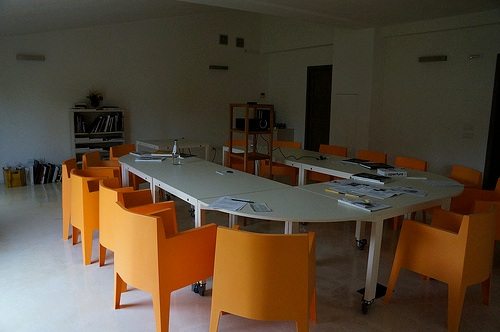
Do you ever wonder where tomorrow’s board leaders will come from? How they will be prepared? Whether they will be as dedicated as the leaders of today? Identifying, recruiting, and preparing board members for the future, has always been a considerable undertaking for many nonprofits.
Girl Scouts of Eastern Pennsylvania (GSEP) has a tradition of training leaders and involving youth in governance. Its practices can provide a framework from which other nonprofit organizations can build a strong board now and in the future.
The Girl Scouts of Eastern Pennsylvania Experience
Girl Scouts of Eastern Pennsylvania serves over forty-one thousand girls, ages five through seventeen, in Berks, Bucks, Carbon, Chester, Delaware, Lehigh, Montgomery, Northampton, and Philadelphia counties. This nonprofit organization is volunteer-based, with over fourteen thousand adult volunteers. Nationally, nearly four million girls and adult volunteers enjoy the Girl Scout experience. Since 2007, when GSEP was formed from three previous Girl Scout councils, girls ages fourteen and older have participated in governance, as members of the board of directors and delegates to the Delegate Council. Not only have girls made an important mark on the organization by lending their voice to policy discussions, they have been able to serve in governance positions, developing skills and interest for later board service in a manner not possible without direct board service.
|
In Their Own Words: Here Is What Girl Advisors Say Being a Girl Advisor helped me feel like I was part of something larger than myself. I felt like I was making a difference for the other girls in the Council. Being a Girl Advisor helped me learn how to network with others. As a Girl Advisor I felt empowered.—Kerry Horn, Girl Advisor 2008-2009 The best part about being a Girl Advisor is being the voice of the girls, and getting to know the governance that enabled the Girl Scouting experience to continue for one hundred years since its establishment in 1912.—Marybeth O’Connor, Girl Advisor 2010-2011 Being a Girl Advisor to the board gave me a glimpse into how Girl Scouting really works as a nonprofit. It showed me a different path to being involved in Girl Scouts—one that “bridged” me to adults and introduced me to council-level work. There are many, many other things I could say about being a Girl Advisor, but one is, it led me to opportunities and connections. From being a Girl Advisor I learned about, applied to, and attended two Girl Scout National Conventions; I helped to shape the future of Girl Scouts of the United States. In addition, I met many inspiring men and women who donated their time to GSEP, and with whom I keep in touch. Some have helped me with school, or jobs, or even life. Others are dear friends, and still others continue to push me to help shape Girl Scouts.—Rachel Lee, Girl Advisor 2007-2008 I’ve learned to apply the critical thinking and problem solving skills on a real world basis, which they can’t teach you in school. I’ve gained mentors and experience working with adults.—Ying Ying Shang, Girl Advisor 2011-2012 |
First, a little background. Girls serving on the board of directors are called Girl Advisors to the Board of Directors. The GSEP bylaws include this position, which specifies that—as with adult nominees—the girls are recruited, or may self-nominate, for the position based on a process established by the board development committee. They are then screened and interviewed by the board development committee. The names of successful candidates for Girl Advisor are listed alongside adult nominees to the board, and voted on at the annual meeting by the Delegate Council in an up or down vote of the full slate.
As an organization serving girls, it is easier for Girl Scouts than many other organizations to involve youth, because of its large ready pool of leaders from which to draw. However, even within the organization, the concept and actual tradition of involving young women at the board level has evolved, and sometimes been hotly debated. According to Natalye Paquin, chief executive officer of Girl Scouts of Eastern Pennsylvania, “Having Girl Advisors at a governance table is revolutionary because the girls are learning first-hand, and in real time, how decisions are made to guide a company.” Paquin sees benefits not only to the organization, but also to the girls as they start their careers. They will be able to recognize how their work specifically fits into the company, and is part of a larger picture.
The benefits to GSEP as a result of the added voices include, a greater understanding of how girls see the future, fresh perspectives, and increased creativity in solving problems. According to Ann Thornton Field, GSEP board chair, “The benefit is that you definitely get a point of view that you would not get from any other source.”
The girls’ involvement as Girl Advisors leads them to be more engaged. They gain a new perspective on the organization as a whole, and are excited by the opportunity to be treated as peers by adult board members. In addition, the Girl Advisors act as role models to other girls. This in turn introduces new governance opportunities to other girls, which increases their engagement overall. Girls have answered surveys saying they stayed involved because of these opportunities.
Girls who are elected for one-year terms to serve as Girl Advisors are generally juniors or seniors in high school. They are experienced Girl Scouts who have been involved in governance for at least a year by participating in Delegate Council meetings. The girls selected are, in Field’s words, “stand-outs.” They receive a special “girls only” orientation prior to the general board orientation, and are assigned an adult board member as a mentor, who will sit beside them at board meetings to answer questions or provide context as needed. Many times the girls ride to or from the meetings with an adult board member and have a chance to learn more about that individual, as well as the work of the board. Girls have full access to the secure web-portal that includes meeting books, financials, and other board information. They, like adult board members, are expected to come to board meetings fully prepared, and to engage in the work of the board.
The board actively seeks the girls’ views during key discussions relating to decisions directly affecting the girls. Carol Watters, past president of one of the legacy councils and a current board member, says that making a point of asking the girls for their views is a key to success. Often the board chair will invite the Girl Advisors to share their thoughts.
|
Are You Kidding? Don’t Board Members Have to Be at Least Eighteen? The laws differ by state. Pennsylvania, like many states, does require board members to be eighteen years of age or older. This is because board members are financially responsible for the organization. Although Pennsylvania law does not allow youth to be full voting members of a nonprofit board, there is nothing said about them serving as nonvoting advisors. Girl Advisors on GSEP’s board are treated as full board members, with the following exceptions: they may not formally vote, and they are excused during executive sessions, especially if these sessions have to do with staffing or sensitive issues. |
Other Governance Opportunities
In addition to Girl Advisor to the Board of Directors, Girl Scouts provides a number of opportunities for girls, ages fourteen and older, to be involved in the governance of the organization. These positions serve as a means to create awareness of other opportunities, and provide training for future service. As mentioned earlier, GSEP has a Delegate Council made up of board and board development committee members, elected delegates, and girl delegate positions. The Delegate Council is part of a treasured and long-standing tradition of member involvement, often called the Girl Scout Democratic Process. The Delegate Council elects the board, board development committee, and girl advisors, and is charged with voting on bylaw changes when required. As the Delegate Council has no financial responsibility, girls can participate as full voting members. They are told they are holding an adult position and will be treated as adults. Girl delegates find that very exciting and rewarding.
Additional opportunities for girls interested in governance occur every three years, when Girl Scouts USA holds a national convention. Each council throughout the United States sends a delegation of voting members. Like many other Girl Scout councils, GSEP elects several girls each convention as voting members. These girls hold the same position as the adult delegates, and are expected to apply the same diligence to studying the issues before voting. All delegates are expected to talk with other GSEP adult and girl members prior to the convention to learn their views, and afterwards to discuss the proceedings and results.
Girls who have served as Girl Advisors are overwhelmingly positive about their experience. According to Ying Ying Shang, Girl Advisor 2011-2012, “The best part is having influence on the policy-making process. As a Girl Advisor, for the first time, I feel like ‘making a difference’ is not some far off dream for when I am fifty—it can happen right now.” Ying Ying’s thoughts are echoed by others, who report that the best part of being Girl Advisors is having their voices heard. Girls also enjoy the unique experience of learning about how GSEP is governed. They appreciate the opportunity to network with adults, and to hold a leadership role within the council.
|
Sync Your Bylaws With Your Ideas Sign up for our free newslettersSubscribe to NPQ's newsletters to have our top stories delivered directly to your inbox. By signing up, you agree to our privacy policy and terms of use, and to receive messages from NPQ and our partners.
|
Adult Reactions
Adults who serve with Girl Advisors on the board are also positive. Ruth Kravitz was the board president of one of the legacy councils during the merger. She has experience working with girls in governance positions that dates back a long time. She believes girls provide critical input to the board. “My experience has been amazing. The girls I worked with would speak up and allow others to understand the importance of youth in the process. Their ideas were generally right on target.”
Are there ever challenges? Absolutely! They include some of the same ones encountered with adults on boards. But in addition, there are a few that are unique to dealing with teenagers. Paquin specifically mentions the importance of ensuring the girls selected for positions will be available for meetings, and are mature enough to maintain the confidentiality required of board members.
In the end, including youth on the GSEP Board of Directors is shaping the organization both now and for the future. It is developing loyal, trained, and willing young people to hold board positions, while providing the organization with the benefits of their ideas. We believe it is worth the challenge, and recommend including youth on boards whenever appropriate.
Lessons Learned
From 2007 through 2011, girls have held approximately 130 governance positions as members of the GSEP or Board of Directors. To determine how to increase the success of the position for both the girls and the organization, GSEP used a survey to assess the experience of Girl Delegates. Here is a sampling of some lessons learned:
Engage Parents and Leaders in Recruiting
The majority of girls first learn about the governance opportunities from their mother or their troop leader. As the position has become more established, the number of girls who learn about the position from other means, such as current Girl Delegates or formal communications, has increased.
Recruiting communications were tailored based on the survey responses. For example, a specific effort was made to share information about the opportunity with mothers of girls, and leaders of troops in the appropriate age group. These women were asked to tell the girls about the positions and attendant benefits, and invite the girls to participate in the process. In addition, board members were available at gatherings of girls in the target age group—as well as those a couple of years younger—to encourage the girls to learn more about the governance positions, and apply for them.
|
Stories from the Real World: Like many councils around the country, GSEP has found it necessary to evaluate the use of its property, including camps. This is a sensitive and emotional topic as Girl Scout camps have many memories and traditions associated with them. The Girl Advisors have shown themselves to be pragmatic and forward-thinking—advocating for the decision that best preserves the financial health of the Council, while providing opportunities for future girls to enjoy camping and the outdoors. Their perspective helps the adults to focus on the mission now, and in the future, and avoid decisions based on the emotional aspects of the issue. Stories from the Real World: When the topic is cookie sales, Girl Advisors bring a progressive perspective to the table. They are more willing than adults to embrace a price increase or other change if it will benefit the troop and the Council. They are also more likely to think the troops can creatively deal with change. Stories from the Real World: Girl Advisors are invited to serve on board and governance, and strategic planning committees as advisors. And most do serve if their schedules and transportation arrangements allow. During a Girl Delegate committee meeting, one of the Girl Advisors suggested running “Strategy Café” discussions just for the girls. Many of the adult members were initially skeptical, but were convinced when a Girl Advisor indicated that the girls would feel more comfortable talking among themselves, and might consider topics that the adults did not discuss. The effort was wildly successful. As an added bonus, it provided additional leadership opportunities for the Girl Advisors and others to lead discussions, prepare reports, and speak before the Delegate Council-an effort that requires speaking with a microphone in front of groups of up to two hundred people. |
Structure Discussions So Girls’ Voices are Heard
The most important suggestion in the initial two surveys had to do with holding discussions at meetings for girls only. Girls requested an opportunity at delegate meetings to hold their own discussions, rather than participate in the discussion groups with adults. Although the adults enjoyed having the girls in their groups, the girls felt that they would have a greater voice if they started by working together, and then reported back to the entire Delegate Council. This change provided opportunities for a Girl Advisor or an experienced Girl Delegate to lead the “girls only” discussions, as well as to go to the microphone and report back to the entire group. One or two board members serve as mentors to this group, but otherwise only girls are present for the discussion.
Recognize Their Service and Contributions
The girls requested recognition of their service in a governance position. They asked for a pin versus the patch more typical in Girl Scouting. They wanted to be able to wear this pin during their tenure in the position. The first pins were awarded at a Delegate Council meeting prior to an annual meeting. Wearing the pins was so popular that a pin was developed and awarded to adult delegates at a later meeting. Girls now receive the pins immediately after their election, and may wear them during their tenure in the position as well as afterwards.
What You Can Do
If your organization is interested in involving youth in governance, here are a few recommendations based on the experience of GSEP.
- Hold an information session for youth and their parents, and/or interested adults. Include current board members. Discuss your plans, and seek input from the young people and adults.
- Consider starting with a youth advisory council focused on governance that will provide an opportunity for input and training for interested young people. To be successful, the group will have to link directly to the board of directors, so consider having board members chair the advisory council and host discussions. This will ensure the group stays focused on governance, and has a direct connection to voting board members.
- Develop a process to seek applications and select individuals for advisory positions to the board. Look to your advisory council as a source for applications. Use your board development committee process to recruit and screen for the youth positions.
- Provide training and mentoring during the term of service, and solicit feedback at the end of the term. Assign one or two board members to specifically work with the girls, and guide them.
- Be sure the board chair and other board members specifically ask the advisors for input during key board discussions. This will ensure that the young people feel their time is well spent, and they are valued.
- Be patient! The tradition of democracy and youth involvement takes time to develop.
- Don’t be discouraged if early on you have low attendance or other problems. Figure out what is causing the challenges, and address it.
You will have to determine the appropriate age of young people for these opportunities. Girl Scouts nationally requires that girls involved in governance be age fourteen or older. Girls aged twelve and thirteen regularly indicated their interest in the position. Although they cannot hold voting positions in the Delegate Council, twelve- and thirteen-year olds have been invited to the “girls only” discussions and training, as a way of preparing them prior to the time they can serve. This age requirement has worked well for GSEP.
It takes time and energy to start involving youth in governance, but is well worth the effort. Among other things, it provides a leadership pool committed to helping the organization fulfill its mission. In the process, young people gain a sense of board service, and an interest in governance, that can launch their volunteer efforts as adults. Some final advice from Paquin: “Just do it! Vet the youth and get them engaged. Your table is not complete without multi- generational diversity.”
Excerpted with permission from You and Your Nonprofit Board: Advice and Practical Tips from the Field’s Top Practitioners, Researchers, and Provocateurs, edited by Terrie Temkin, PhD.









